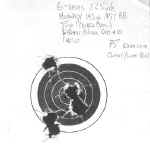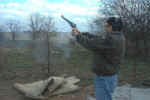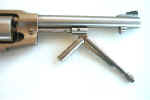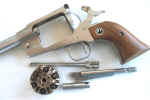The Ruger Old Army KBP 7
A Jim Taylor/A K Church joint
conspiracy
January 2002
(Free permission to quote Church's articles is granted, as long as proper attribution is given. We request that if you use our work, you give us credit.)
The blackpowder revival of the 1960s accelerated exponentially in the 1970s. In the main, it was fueled by nostalgia, and the vast majority of mid 20th Century blackpowder guns were reproductions of guns that had seen light by the Andrew Johnson Administration.
Ruger, on the other hand, set the bar higher and endeavored to create a blackpowder utility gun. Introduced in 1972, and available in stainless by mid year 1975, the Old Army succeeded. While the Old Army is never going to suit the needs of Buckskinners and Civil War re-enactors, it amply fills the niche of a 20th Century blackpowder working gun of great reliability.
The Test Gun
Select
the image for a larger view

The Ruger Old Army is a 6 shot single action percussion revolver. Nominally listed as ".44 caliber", groove diameter is .457, making it a member of the .45 club. This one is stainless, and is designated as the KBP-7. Author Taylor is no great fan of stainless, but the Old Army at least uses blued sights on both ends, so sight picture is conventional. No Smith 629 red on stainless business with this one.
Ruger took the majority of the lockwork mechanical details from the Old Model Blackhawk. Some details seem derivative of better 19th century designs. The hammer safety notches on the rear of the cylinder are very much like the Fordyce Beals 1858 designs for Remington, as is the frame forward of the cylinder. The cylinder retention may give a passing nod to the Whitney Navy, as does the Chinese puzzle loading lever. The XR3-RED gripframe is based, albeit loosely, on the M1851 Navy/Single Action Army grip frame.
However Ruger's blank slate engineering approach shows up in many areas. The nipples are hex headed, strip resistant, and the hammer tolerances allow enough standoff from those nipples to allow safe dry firing. Coil springs are exponentially more durable than 19th century leaf springs, those coil springs and the fully adjustable rear sights with Baughmann front all are touches which would have been unknown to 19th century armorers. Metallurgy is unimaginably better than anything from the Victorian era.
Our test gun is a recent production stainless number, serialed 145-81XXX. It was obtained as a low mileage well maintained creampuff from the first owner, and run through its paces.
Shooting Observations
Conventional wisdom holds the Old Army to be set up for round ball loads, over a maximum of 40 grains of 3F powder. Ignition is by a #10 or #11 percussion cap, and most experienced shooters tell me they give Remington caps the cold shoulder for any serious work. Front sight height appears to indeed be set up for round ball. The conventional wisdom load is usually therefore listed as a 144 grain round ball at 900-950 feet per second. Modern technocrats may well belittle the sectional density and ballistic coefficient of this projectile, but less well informed 19th century hunters just went on and killed deer with this arrangement anyway. Deer haven't changed much in the last 150 years, so we operated on the belief this would still kill deer if ranges were kept short (50 yards or less), and placement was kept exact. For the 2001 Missouri Black Powder Whitetail season, this one was indeed carried. But to kill a deer, youíve got to see a deer, and Jim didnít...
Jim adds a note: Actually I saw deer. I had set a 50 yard maximum limit on myself and never got a deer within that range. So while I "saw" deer, I did not see any "shootable" ones by my self-imposed criteria.
Author Church previously used the 220 grain Lee conical in a blued gun set up for that bullet. Load for the heavier longer bullet had to be reduced, conventional loading techniques limited charge weights to 35 grains of Gearhart Owen 3F. This theoretically was an 850 foot second load, but in those Reagan era days Church never so much as saw a chronograph. Caps were usually Italian #11, and lubricant was Crisco, or on extremely hot days, red lithium grease. Crisco gets runny in high heat and humidity, and is about impossible to wash out of denim.
It remains married to its cap Ďn ball heritage, too, in that reliability is still dependant on the cap giving enough flame to the powder. We experienced one failure at the range with a Navy Arms brand cap old enough to legally buy alcohol. Remingtons also have a poison reputation.
Note well: Despite many questions about its durability with smokeless, we avoided this practice. Ruger considers it unsafe, so we didn't try it, and advise against it. If you blow your gun up, it won't be because we told you to try stuffing it full of 4198 or W231. We told you not to.
Owner #1 sent his revolver on with the following group enclosed in the paperwork:
Select
the image for a larger view

Specifics, if the image can't be read, are 6 shots @ 25 yards, Hornady .457 round ball, 35 grain equivalent of Pyrodex "P", RWS Dynamit Nobel #10 cap, and Crisco lube. This is altogether serviceable accuracy.
We discovered this: Front sight height is definitely set up around the round ball load. With a Keith type projectile impact was way high: 25 yards out it was hitting a solid 12 inches high. A taller front sight blade is a simple fix, and one is in the future, likely in a Patridge configuration. In these later models, the front blade is attached with one roll pin.
Chronograph and range results are as follows, the Reverend Taylor shooting and measuring all:
All
loads chronographed at 12 feet from muzzle to first screen
All loads used CCI #11 caps
| Bullet | Powder | Charge | Velocity |
| 178 gr. conical * | FFg DuPont | 40 gr. | 960 fps |
| FFFg DuPont | 40 gr. | 1011 fps | |
| Pyrodex P | cylinder full | 1120 fps | |
| Duplex load * | 10 gr. FFFg cyl. full of Pyrodex P |
1160 fps | |
| Cast Performance 250 gr. FP |
FFg DuPont | 30 gr. | 820 fps |
| Pyrodex P | cylinder full | 957 fps | |
| Duplex load * | 10 gr. FFFg cyl. full of Pyrodex P |
990 fps |
*
These loads are safe in THIS gun.. you use them at your own risk.If you break your pistol DO NOT try to blame it on us.
*
The conical bullet is a home-made one
..
Select the image for a larger view
 Allen Taylor made the conical mold by running a .452" diameter reamer into a
.457" Lee round ball mold. This made a neat little conical bullet
that has proven pretty accurate in the .45 Colt and shot fairly well in Ruger
Old Army. It can also be loaded backwards for a nice full wadcutter in the
Old Army.
Allen Taylor made the conical mold by running a .452" diameter reamer into a
.457" Lee round ball mold. This made a neat little conical bullet
that has proven pretty accurate in the .45 Colt and shot fairly well in Ruger
Old Army. It can also be loaded backwards for a nice full wadcutter in the
Old Army.
Specifications:
Barrel length: 7 1/2 inches, 6 groove, 1-16 inch twist. Weight: 46 ounces. LOA: 13 3/4 inches. All information lifted openly from "GUNS ILLUSTRATED 1991".
The weight on the gun is about midway between the basic long barreled Blackhawk, and the rib topped Hunter model. Recoil is a long slow rise, more considerable in amount than expected, but gentle in effect because of the dwell time. Note the recoil rise from horizontal in the MPEG below. Author Church was startled in seeing the sequence, since he perceived the recoil rise to be very much less than it was.
FILM AT 10:00 This is an mpeg of AK Church firing the Old Army. File is 1.88 MB download and can take up to 15 minutes on a slow connection.
Conclusions
The Old Army may lack the romance of the Old West, but for a working blackpowder gun, the durability and reliability canít be beat. Missouri game regulations allow unfilled deer tags from Firearms Season to be used in Blackpowder Season, and Iím hard pressed to think of a better sixgun for the job.
Select
the image for a larger view

Email Jim Taylor for further education
Email A K Church for obfuscation and backpedaling
NOTE: Author Church regrets that he is unqualified to do appraisal, and cannot establish a value on your gun.
visitors since website crashed AUG 2003
EMAIL AK CHURCH
(Remember that hand loading is done at your own risk.)
Added 4 SEP 2003
Thanks for the site on the old army, just have a few things that may be of interest. I turned and hardened a small die to fit the Lee conical, just a cylinder that is a snug fit for the bullet with the nose sticking up .100, file off the .100 of lead and you end up with Keith style ( much better for hunting deer) and you now have enough room for 40grs. of Triple 7 or Pyrodex . The old army will handle all the P.B. or substitutes you can fit into the chamber. I have even gone one step further and ground a ball mill cutter to fit the cylinder and took out a few thousands out of each chamber , just enough to make them all the same depth. I make a peep sight blade for the rear sight and mill a dovetail up front and install a rifle glowworm sight , we hunt in Wisc. and the Firesight is great in the shadows . I do a lot of hand loading and never hotrod any cartridge, that said, the old army no doubt could handle 40.000cup and the above scenario should be less than 15000 cup.
God Bless America


